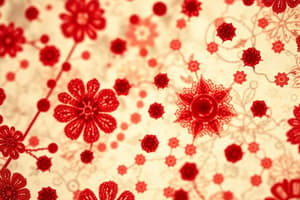Podcast
Questions and Answers
What are the functions of the iris diaphragm and condenser?
What are the functions of the iris diaphragm and condenser?
The iris diaphragm regulates how much light is on the object being viewed, and the condenser focuses light into an objective as it moves up and down enhancing specimen contrast.
Name the three main objectives used on a clinical microscope.
Name the three main objectives used on a clinical microscope.
10x, 40x, and oil immersion 100x
Explain the uses of the course and fine adjustments.
Explain the uses of the course and fine adjustments.
The course adjustment is used to focus with the low power objective and focusing with a high power could result in damaging the slide or the objective lens; the fine adjustment is used once the course adjustment puts the object into view to give a sharp image.
Describe the proper method of cleaning a microscope after use.
Describe the proper method of cleaning a microscope after use.
How should a microscope be stored when not in use?
How should a microscope be stored when not in use?
When is oil immersion used on a slide?
When is oil immersion used on a slide?
Explain how to adjust the interpapillary distance on a distance microscope.
Explain how to adjust the interpapillary distance on a distance microscope.
When is the oil immersion objective used?
When is the oil immersion objective used?
What is the purpose of making a dioptic adjustment and how is the adjustment made?
What is the purpose of making a dioptic adjustment and how is the adjustment made?
How is total magnification calculated on a compound microscope?
How is total magnification calculated on a compound microscope?
How do electron microscopes differ from light microscopes?
How do electron microscopes differ from light microscopes?
When must standard precautions be used with a microscope?
When must standard precautions be used with a microscope?
What is Kohler illumination and how is it performed?
What is Kohler illumination and how is it performed?
Why is a condenser not used in epi-fluorescence microscopes?
Why is a condenser not used in epi-fluorescence microscopes?
Why are electron microscopes not for routine use in the clinical lab?
Why are electron microscopes not for routine use in the clinical lab?
Explain how the image formed in the Transmission Electron Microscope (TEM) differs from that found in Scanning Electron Microscope (SEM).
Explain how the image formed in the Transmission Electron Microscope (TEM) differs from that found in Scanning Electron Microscope (SEM).
Explain the difference between lenses that are parfocal and those that are parcentric.
Explain the difference between lenses that are parfocal and those that are parcentric.
Flashcards are hidden until you start studying
Study Notes
Microscope Components and Functions
- The iris diaphragm controls the amount of light reaching the specimen, while the condenser focuses this light to enhance contrast.
- Common magnification objectives on clinical microscopes include 10x, 40x, and oil immersion at 100x.
Focusing Techniques
- The coarse adjustment is for focusing with low power objectives, while the fine adjustment sharpens the image after initial focus.
- Oil immersion is utilized for high magnification, particularly after low power focusing, enhancing detail in specimens.
Microscope Maintenance and Storage
- Clean only with lens paper to avoid scratching; replace any damaged or cloudy lenses for optimal viewing.
- Store the microscope with the stage up, the lowest objective in place, and cover it with a dust cover in a secure cabinet.
Adjustments for Viewing
- Interpapillary adjustment is done by modifying the distance between oculars until only one image is seen.
- Dioptic adjustment ensures a sharp focus by alternating between eyes and fine-tuning with the knurled collar.
Total Magnification
- Calculated by multiplying the objective lens magnification by the ocular lens magnification for the compound microscope.
Microscope Types and Precautions
- Electron microscopes use an electron beam, offering superior quality compared to light microscopes but are costly and require specialized training.
- Standard precautions with microscopes include ensuring electrical cords are undamaged and keeping liquids away from them.
Illumination Techniques
- Kohler illumination aligns the light path with the specimen using the field diagram for better visualization.
- In epi-fluorescence microscopes, condensers are unnecessary as the light is provided directly from the specimen.
Differences in Electron Microscopy
- Transmission Electron Microscopy (TEM) utilizes electron beams through specimens, while Scanning Electron Microscopy (SEM) directs electron beams over specimen surfaces.
- Parfocal lenses maintain focus across different objectives with minimal adjustment, whereas parcentric lenses keep the specimen centered as objectives change.
Studying That Suits You
Use AI to generate personalized quizzes and flashcards to suit your learning preferences.




